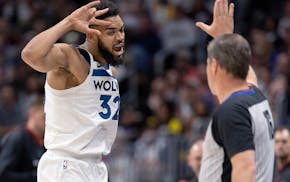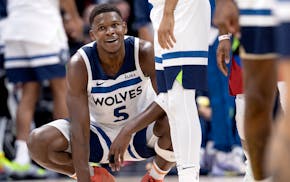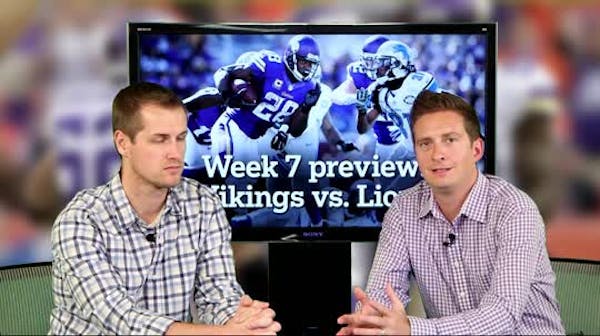At times last Sunday, Adrian Peterson looked a bit like Barry Sanders, darting away from a clogged line of scrimmage only to get tackled in the backfield while trying to make a spectacular play.
Sanders may have been the most elusive and unpredictable back in NFL history. He was also the most inconsistent because of his willingness to gamble. As the Vikings prepare to play in Detroit today, that isn't the only way Sanders and Peterson are comparable.
Sanders was short and squat. He used his powerful legs to dart and make jump cuts, and he sometimes hid behind his blockers until he found an opening. Peterson is taller and more powerful, more likely to finish a run by lowering his shoulder or sprinting toward open field in a straight line.
Sanders made defenders miss. Peterson often makes defenders wish they had.
Despite dissimilar styles, their careers look an awful lot alike.
Both rushed for 2,000 yards once. In his ninth season, Peterson has averaged 4.9 yards per carry. Sanders averaged 5.0. Peterson has averaged 97 yards rushing per game. Sanders averaged 100. Peterson has averaged .82 touchdowns per game, Sanders .69.
Peterson is the better goal-line back, Sanders the more frequent receiver. Both have averaged 8.3 yards per catch.
Sanders averaged 1,527 yards rushing per season. In Peterson's first seven seasons (leaving out five games this year and one last year) he has averaged 1,445.
Both lost in one NFC championship game. Both played in one winning playoff game, beating Dallas in that game.
There is another Dallas tie between them. Both have many reasons to envy Emmitt Smith.
Smith holds the NFL record for rushing yards with 18,355. He scored 164 rushing touchdowns. He won three Super Bowl titles. He was the pivotal player on the Cowboys' championship teams, which often performed well when quarterback Troy Aikman was injured but hardly ever won without Smith.
Smith wasn't as powerful as Peterson. He wasn't as spectacular as Sanders. He averaged 5 yards a rush in only one season, and that was the only season he averaged more than 4.7. He averaged 1,223 rushing yards per season, and averaged less than 4 yards a rush in his last four.
Smith played behind a massive and celebrated offensive line. He played for a dominant team. What really separates him statistically from Sanders and Peterson is that he wanted to, and was able to, stay on the field and extend his career.
Sanders quit football after 10 seasons. Had he played another three years, he would probably hold the rushing record.
Peterson missed 15 games last season because of what amounted to a season-ending suspension after he beat his son with a switch. Had he put together a representative season, he would probably be near 12,000 rushing yards, with a good chance of passing Sanders and an outside chance of challenging Smith.
At his traditional pace, Peterson will need five-plus representative, healthy seasons to pass Smith. That's five seasons without a dropoff, a rarity among aging running backs.
Smith fell off dramatically in his final years and was willing to leave Dallas to play for a bad Cardinals team to elevate his record.
Sanders was frustrated by losing and walked away from football with his health intact. Peterson has always expressed different priorities. He wants to break Smith's record and establish himself as the greatest running back ever.
In my last one-on-one interview with Peterson, before last season began, he spoke of wanting to finish his career with the Vikings, and wanting to prove he was the best football player who ever lived. While he paid lip service to remaining a Viking, he sounded as if playing as long as possible was his top priority.
His suspension, running style and age may keep Peterson from challenging Smith's record.
Unlike Sanders, Peterson's quest probably won't end voluntarily.
Jim Souhan's podcast can be heard at MalePatternPodcasts.com. On Twitter: @SouhanStrib. • jsouhan@startribune.com

Souhan: Wolves best team in the NBA, even if they can't say it yet

Souhan: Even as winning streak ends, Jeffers continues to thrive

Souhan: Edwards is inspiring comparison to ... you know who
Souhan: A sausage? A knee surgery? Minnesota sports has gone mad


